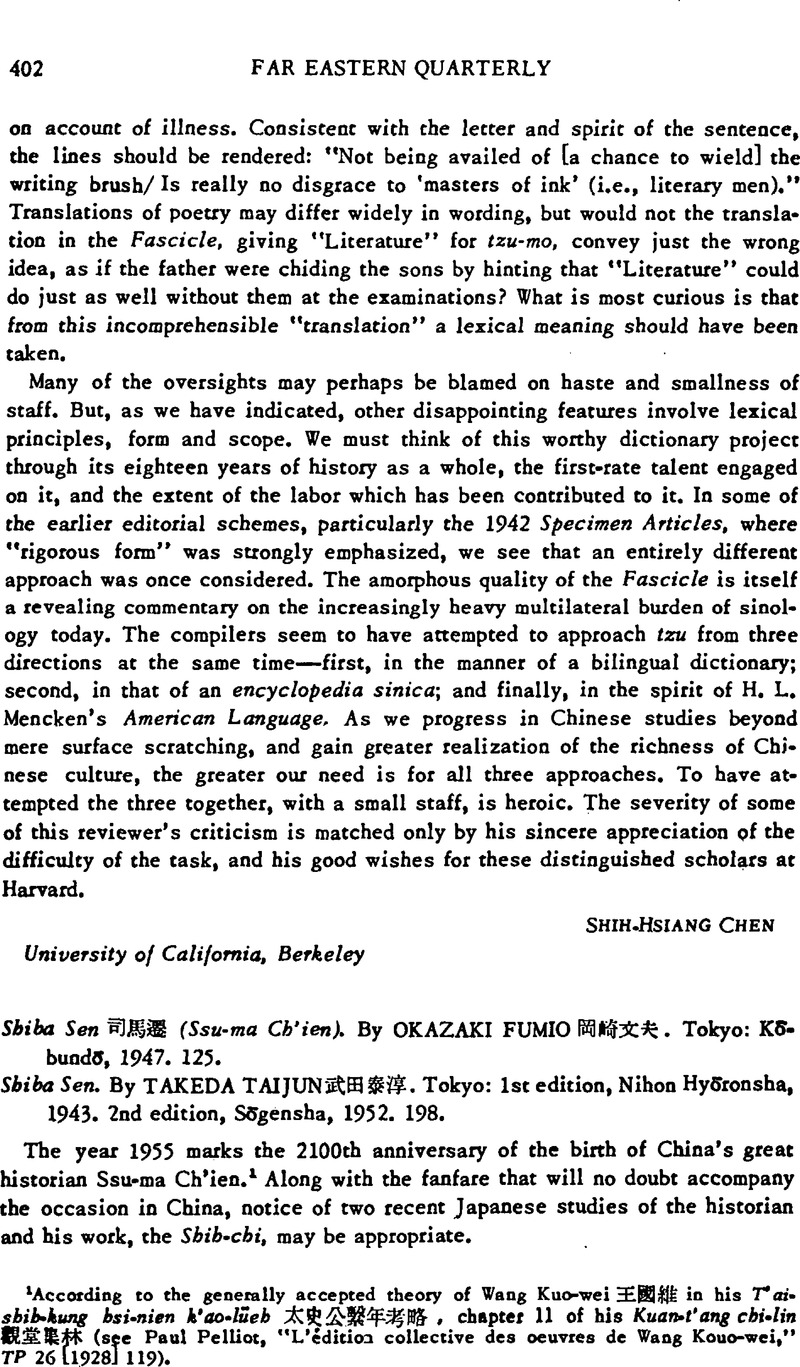No CrossRef data available.
Published online by Cambridge University Press: 23 March 2011

1 According to the generally accepted theory of Wang Kuo-wei ![]() in his T aisbib-kung bsi-nien k'ao-lüeb
in his T aisbib-kung bsi-nien k'ao-lüeb ![]() chapter 11 of his Kuan-t'ang chi-lin
chapter 11 of his Kuan-t'ang chi-lin ![]() (see Paul Pelliot, “L'édition collective des œuvres de Wang Kouo-wei,” TP 26 “1928” 119).
(see Paul Pelliot, “L'édition collective des œuvres de Wang Kouo-wei,” TP 26 “1928” 119).
2 Kametarō, Takigawa![]() . Shiki kaichū kōshō
. Shiki kaichū kōshō ![]() (Tokyo, 1934) 130Google Scholar “= vol. 10].18–19 and 130.26–27.
(Tokyo, 1934) 130Google Scholar “= vol. 10].18–19 and 130.26–27.
3 Hsien-ch'ie, Wang![]() , Han-shu pu-chu
, Han-shu pu-chu ![]() (Changsha, 1900) 62.24a–b.Google Scholar
(Changsha, 1900) 62.24a–b.Google Scholar
4 On the Shib-chi as a work of literature and its importance in the history of Chinese literature, see two short essays by the same title, “Shiden no bungaku” ![]() (The Literature of historical biography), one by Shigeki, Kaizuka
(The Literature of historical biography), one by Shigeki, Kaizuka![]() in Chūgoku kodai no kokoro
in Chūgoku kodai no kokoro ![]() (The Mind of ancient China) (Tokyo, 1951) 110–126Google Scholar, the other by Kōjirō, Yoshikawa
(The Mind of ancient China) (Tokyo, 1951) 110–126Google Scholar, the other by Kōjirō, Yoshikawa![]() in Chūgoku e no kyōshū
in Chūgoku e no kyōshū ![]() (Nostalgia for China) (Tokyo, 1951) 50–55.Google Scholar Ssu-ma Ch'ien himself seems to have had one general theory of the motivation and purpose of literature which he applied equally to history, philosophy and poetry. His own work has been admired and read by his countrymen not as a chore to inform themselves of the past but as a source of keen literary enjoyment. I wonder, incidentally, if anyone has ever considered whether the late development of the novel in China and its relatively early appearance in Japan is related in any way to the liveliness of early Chinese histories and the fantastic and dull nature of early Japanese ones.
(Nostalgia for China) (Tokyo, 1951) 50–55.Google Scholar Ssu-ma Ch'ien himself seems to have had one general theory of the motivation and purpose of literature which he applied equally to history, philosophy and poetry. His own work has been admired and read by his countrymen not as a chore to inform themselves of the past but as a source of keen literary enjoyment. I wonder, incidentally, if anyone has ever considered whether the late development of the novel in China and its relatively early appearance in Japan is related in any way to the liveliness of early Chinese histories and the fantastic and dull nature of early Japanese ones.
5 At the end of the book he has a convenient chronological table of the life of the historian according to the dates given by four leading scholars.
6 Shiki kaichū kōshō 130.7–14.
7 Wang Ming-sheng ![]() , Shih-ch'i shih shang-ch'ūeh
, Shih-ch'i shih shang-ch'ūeh ![]() 6.8b, in the edition of the Kuang-ya ts'ung-sbu
6.8b, in the edition of the Kuang-ya ts'ung-sbu ![]()
8 It is interesting to note that there are fewer evidences of pre-conceived concepts of the evolution of history in the Shih-chi than in the Han-shu, which was written in a purely Confucian spirit. Both Pan Piao and Pan Ku at least publicly expressed belief in the “inevitable” downfall of the Ch'in and the “inevitable” rise of the Han under the Liu family.
9 Yü-fu, Chin![]() , Chung-kuo shih-hsūeh
, Chung-kuo shih-hsūeh ![]() (Shanghai, 1936) 48.Google Scholar
(Shanghai, 1936) 48.Google Scholar
10 A notable exception seems to be the “Basic Annals of Empress Lū,” which contains the full account of her many lurid crimes. Perhaps Ssu-ma Ch'ien considered her too bad to be worth bothering with. Pan Ku reconsidered the dignity of the royal family and sorted out the scandalous parts, relegating them to another section of his history.